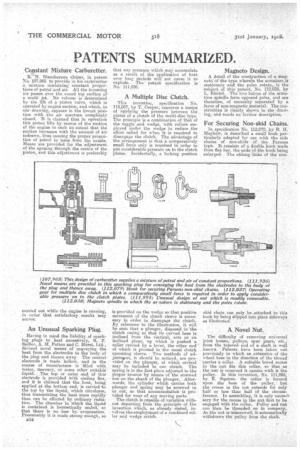PATENTS SUMMARIZED.
Page 24

If you've noticed an error in this article please click here to report it so we can fix it.
Constant Mixture Carburetter.
R' N. Blanchereau claims, in patent No. 107,965 to provide in his carburetter a Mixture containing constant proportions of petrol and air. All the incoming air passes over the coned top surface ofa multi jet. Its volume is determined by the lift of a piston valve, which is operated by engine suction, and which, in our drawing, appears in the lowest position with the air aperture completely closed. It is claimed that in operation this piston lifts by-reason of the suction of the engine to such an extent that the suction increases with the amount of air indrawn, thus causing the proper proportion of petrol to issue from the nozzle. Means are provided for the adjustment of the opening through the centre of the piston, and this adjustment is preferably
carried out while the engine is running, in order that satisfactory results may accrue.
An Unusual Sparking Plug.
• Having in mind the liability of sparking plugs to heat excessively, R. F. Spiller, A. M. Patton and C. Hurst, Ltd., devised novel means of 'conveying the heat from the electrodes to the body. of the plug and thence away The central electrode is made hollow, and in the course of manufacture is filled with water, mercury, Or some other suita,b16 liquid. The top or outer end of this electrode is provided with cooling fins, and it is claimed that the heat, being applied at the bottom end, is carried to the top by the liquid; which circulates, thus transmitting the heat more rapidly than can be effected by ordinary• radiation. The chamber in which the liquid cont, teed is hermetically sealed, so that there ia no loss by evaporation. Presumably it is made strong enough, so S354 that any pressure which may accumulate as a result of the 'application of heat over long _periods will not cause it to explode. The • Patent specification is No: 111,936.
A Multiple Disc Clutch.
Tiiis invention, specification No. 112,037, by T. Cooper, concerns a mean.s of applying the pressure between the plates of a clutch of the multi-disc 'type. The principle is a combination of that of the toggle and wedge, with rollers employed under the wedge to reduce the effort called for when it is required to disengage the clutch. The advantage of the arrangement is that a comparatively small force only is required in order to put considerable pressure on to the chitch plates. Incidentally, a locking position is provided on the wedge so that positive movement of the clutch sleeve is necessary in order to disengage the clutch. By reference to the illustration, it will be seen that a plunger, disposed inathe clutch casing so that its curved base is inclined from the vertical, acts as an inclined plane, up which is pushed a roller carried by a lever, the other end of which is pivoted to the usual clutch operating sleeve. Two methods of adjustr4gut, it should be noticed, are provided on the plunger, of which several may be included to one clutch. The spring is in the first place adjusted to the proper tension by means of the screwed nut on the shank of the plunger. Afterwards, the cylinder which carries both plunger and spring may be screwed in or out, so that accommodation' is provided for wear of any moving parts.
The clutch is capable of variation without departing from the principle of .the invention which, as already stated, involves thesemployment'of a combined roller and wedge actidh,
Magneto Design.
A detail of the construction of a magneto of the type wherein the armature is stationary and the poles rotate, is the subject of this patent, No. 112,038, by L. Bleriot. The two halves of the armature spindle form opposed poles, and are therefore, of necessity separated by a layer of non-magnetic material. The construction is clearly shown in the drawing,and needs no further description.
For Securing Non-skid Chains.
In specification No. 112,079, by R. H. Mayhew, is described, a small hook particularly adapted for use with the side chains of non-skids of the Parsons type, It consists of a double hook made from flat bar, the ends of the hook being enlarged. The oblong links of the non
skid chain can only be attached to this hook by being slipped into place sideways as illustrated.
A Novel Nut.
The difficulty of removing universal joint bosses,' pulleys, spur gears, etc.; from the tapered end of a shaft is 'well known. . Patents. have been taken out previously in which an extension of the wheel boss in the direction of the thread. "carries a collar. A suitable bored recess in the nut fits this collar, so that as the nut is removed it carries with it the pulley. In this invention, No. 111,995, by E. Squires, the collar is formed upon the boss of the pulley, but the recess in the nut extends for only half or less than half of the circumference. In assembling, it is only necessary for the recess in the nut first to be engaged with the collar. Pulley and Mit can then be threaded on in company. As the nut is unscrewed, it automatically withdraws the pulley from the shaft.
























